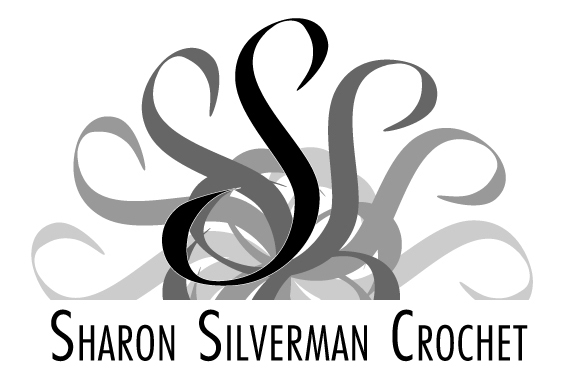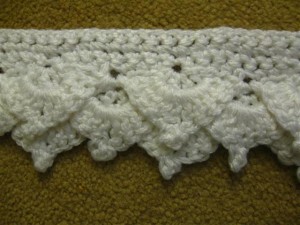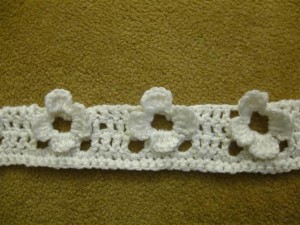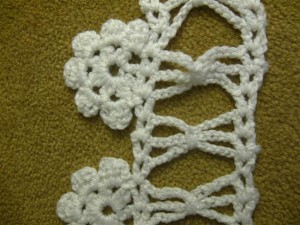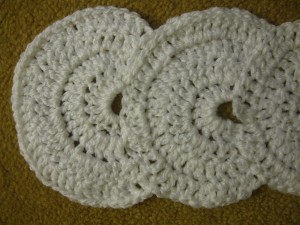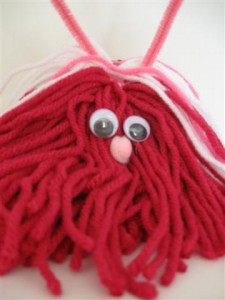Several crochet books have come across my desk in the past month. Most are pattern books or stitch guides, but one is in a genre all its own: Crochet Saved My Life by Kathryn Vercillo.
I do not know Kathryn personally, but I regularly read her blog (at her website, www.crochetconcupiscence.com). She honored me by making a month's worth of scarves from my book, Crochet Scarves, and writing about her experience on her blog. We have had pleasant email correspondence. I purchased her book on Amazon, and I consider the following review thorough and unbiased. I hope you feel the same.
Crochet Saved My Life is part memoir and part compilation of stories, with a wealth of cited research and a hefty dose of self-help techniques. I was pleasantly surprised by the depth of the content. The title and promotional material had me expecting a Chicken Soup for the Crocheter's Soul kind of book, and this is so much more. From a marketing standpoint, Kathryn might do well to expand the way she talks about the book so potential readers in academia and the helping professions know that it's not just a collection of personal essays. Crochet Saved My Life would make an excellent teaching tool in medical schools, nursing curricula, and rehabilitation facilities. With a little reworking, the book could be made into a series of lectures--Kathryn's approach is one of a natural teacher. If she has any thoughts about pursuing a doctorate, I think the research she has done for this book puts her well on her way toward a thesis!
That said, the heart of the book is in the two dozen personal stories Kathryn has collected. These are not easy to read. They are all from people (most who give their real names, some who prefer to remain anonymous) who have had serious, often life-threatening problems. You may recognize some of the women as big names in the crochet world (Laurie Wheeler, Fearless Leader of the Crochet Liberation Front; Tammy Hildebrand, Crochet Guild of America board member). Essays from people who suffer from depression, assault, multiple sclerosis, autism, schizophrenia, and other mental and physical ailments serve as sobering reminders that life is often difficult, and that for some people, merely getting out of bed every day is a challenge. We wonder, "How do they cope?" with their situations, while at the same time we empathize with and admire each woman's strength and lack of self-pity. Reading their own words made me feel connected to the writers and removed any protective wall I could have built between "me" and "them." It's clear that all of us are just one accident, one genetic flaw, one natural disaster, one setback away from being in their shoes. Kudos to Kathryn for seeking out these powerful stories and to the women for sharing them.
No matter what the underlying problem, every woman in the book has found that crocheting is helpful for mental and/or physical health. Kathryn does a fine job examining the aspects of crafting that are important. She mentions the sense of accomplishment that comes with doing a project (as opposed to reading or watching TV), the opportunity to be creative, the satisfaction with doing something productive and useful when one has severe limitations, and the calming aspects of repetitive motion. Kathryn is also very insightful when it comes to examining how crochet can be a safe bridge to others. Having something in one's hands invites non-threatening conversation while not requiring unremitting eye contact. Interacting with other crafters, in person or online, puts people with a common interest together.
The memoir presented in the greatest detail is, of course, Kathryn's own. "Brutally honest" is not an overstatement. Kathryn's vivid description of her descent into depression, the series of even-sicker-than-she-was men she took into her life so she could "help" someone worse off than she was, her bouncing around from one city and one job to the next, and her uncertainty about whether she wanted to live or die strip away all pretense. The picture is raw, but it needs to be:
"I did not want to die but I most definitely wanted to be dead. I did not see the point to life. All I saw was this endless cycle of having to continue waking up and feeling this horrible way forever. I knew from experience that no matter how much I tried to distract myself with men or friends or activities or social causes or jobs I was going to end up right back here on the bathroom floor with the tip of a kitchen knife poised to go into my arm."
What Kathryn did was to summon up every ounce of strength and determination she had and replace the knife with a crochet hook. She is very clear that crocheting did not turn her into a healthy person. Good therapy, appropriate medication, and lifestyle changes were all part of her recovery. But the experience of crocheting kept her alive long enough to get the help she sorely needed. It was a turning point.
Kathryn's experience with the redemptive aspects of crocheting got her thinking about other people who may craft for health. She found study after study (eleven pages worth in the bibliography) that explained different conditions and diseases, and examined the long-term benefits of crafting in general and crocheting in particular. It will come as no surprise to any crafter that the act of creating something, the meditative nature of making stitch after stitch, and the distraction from inner thoughts have enormous benefits. I'm sure I'm not the only one who has been up in the middle of the night worrying about this or that, or has been nervously sitting in a medical waiting room, only to start crochetiong and then realize that minutes have gone by without me dwelling on whatever was bothering me.
I'm not going to recount the book's content in depth--you should read it yourself. It starts with Kathryn's story, then is divided into sections based on particular disorders (anxiety, OCD and addiction, PTSD, schizophrenia, bipolar, and so on). The book includes sections on stress reduction, pain management, occupational therapy, and crocheting for caregivers, and concludes with mindfulness and hand exercises. Essays from crafters appear as apprioriate in each chapter. Thank you, Kathryn, for presenting these moving stories to us and for making a strong, well-researched case for the health benefits of crochet. I give a hearty endorsement to everything you included in the book.
The content gets A+. I'm less enthusiastic about the form. Right up front, you should know that I have been a professional writer and editor for more than 25 years. Mechanics are important to me not because it makes sense to adhere slavishly to rules, but because following those rules paves the way for clear writing.
Do I make mistakes? Sure. I may even make one or two in this blog entry--but it's a blog entry (and WordPress is so fickle, I sometimes have no idea what my published words will look like)! The stakes are higher for a published book, and therefore more rigorous standards of proofreading and editing are required.
Kathryn states that she struggled with whether to include excerpts from the women's stories in the text, as well as publishing the entire stories at the end of a section. She chose to do the former, and although I see her point, I think this was a mistake. I found it distracting to read a large portion of a two-page essay, only to read the whole thing again a few pages later. It would have been better to have imposed more structure and eliminate the redundancy.
The crafters' stories combine narrative from Kathryn and first-person stories from the crocheters. Each "Meet So-and-so!" isn't exactly an interview, or an essay, or a Q&A. It's a little choppy, and I don't think the narrative (after the brief introduction to the essay) adds anything. Better to have kept everything in first person.
The margins bothered me. Why is there so little space on the outer edges of the pages?
Diagrams for the hand exercises would have been nice.
A few things made me cringe. "Its" without an apostrophe is incorrectly used as a contraction for "it is" in the first quoted paragraph on p. 110. (If the submitter wrote it like that, it would have been fine for Kathryn to correct it.) Think of "its" in the same possessive category as "his" and "hers." No apostrophe is needed for any of those. For the contraction of "it is," an apostrophe is required. On p. 114, the bewildering phrase "a little bit unique" is used. Either it's unique, or it isn't! On p. 116 a word is missing when Kathryn says she hung it "on my colorful living room." I assume she means "my colorful living room wall."
There are numerous instances of punctuation used incorrectly inside or outside parentheses. For example, on p. 123, third full paragraph, there needs to be a period outside the right parenthesis. Ditto with the second full paragraph on p. 136. Similar errors are made with quotation marks; I won't bore you with the list. It's time for the author to review a good style guide. The page numbers listed in the Table of Contents do not always match where the information actually is ("Meet Laurie!" is on p. 145; ToC lists it as p. 146).
The clunker that made me throw the book off my lap and yell, "Oh, come on!" is at the end of the first paragraph on page 152. Kathryn uses "illicit," meaning "forbidden by law, rules, or custom" when she was trying to say "elicit," meaning "evoke or draw out."
These are typical first draft errors. Unfortunately, this is the published version, not the first draft. Reading the manuscript aloud might have helped Kathryn catch some of the mistakes herself (indeed, she may have found some after publication and if so, I'm sure she's chagrined that they got through). But there is no substitute for getting another pair of eyes--preferably a trained, ruthless pair--to review a book before it goes to print! As writers, we see what we expect. Occupational hazard. Believe me, I can understand the eagerness to get to press, and the confidence that everything is good to go, but it would have been better if Kathryn had taken a step back before printing. Each error is not a big deal, but they add up to an unfortunate sloppiness that has "Self-Published!" written all over it, and which detracts from the content. I expected more from someone whose website is "Crochet Concupiscence" and who knows what "concupiscence" means.
To sum up, Crochet Saved My Life is an important volume on a number of levels: as a memoir, a self-help book, a survey of the current literature, and a teaching tool. I highly recommend it for the content. If it sells well enough, author Kathryn Vercillo will be able to correct the technical errors before the next printing, elevating the form to match that of the excellent material.
